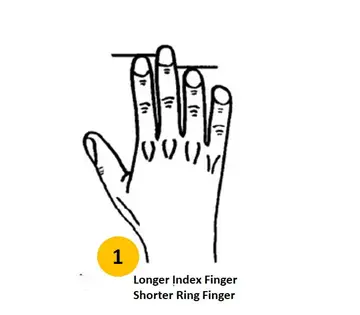Can Finger Length Reveal Personality Traits?
The idea that finger length can determine personality traits might sound like something out of a fortune teller’s handbook. However, a pseudoscientific concept, known as the “digit ratio,” has gained surprising traction in linking finger proportions to individual characteristics.
The concept hinges on the ratio between the index finger (2D) and the ring finger (4D), often referred to as the 2D:4D ratio. Despite its pseudoscientific nature, this theory has sparked curiosity, inspired over 1,400 studies, and even ventured into the realm of evolutionary biology and prenatal development.

The Interpretations of Finger Length
According to proponents of the digit ratio theory, finger lengths correlate with certain personality traits.
- Longer Ring Finger (Low 2D:4D Ratio)
People with longer ring fingers are believed to exhibit traits such as assertiveness, risk-taking, and high self-esteem. These individuals are said to be competitive, ambitious, and outgoing, often thriving in challenging situations where their competitive nature shines. - Longer Index Finger (High 2D:4D Ratio)
A longer index finger is associated with compassion, empathy, and strong communication skills. These individuals are thought to be nurturing and conflict-averse, favoring cooperation over competition in most situations. - Equal Finger Lengths
When the index and ring fingers are roughly equal in length, the individual is theorized to have a balanced personality. They might display both assertive and empathetic traits, adapting their behavior based on the circumstances.
The Science Behind the Theory
While the digit ratio theory is far from scientifically conclusive, it is rooted in an intriguing area of research. The idea originated with evolutionary biologist John Manning, whose studies at Swansea University popularized the link between finger ratios, prenatal hormone exposure, and personality traits.
In the 1950s, researchers began exploring the connection between prenatal testosterone levels and various behavioral and cognitive traits. Since directly sampling fetal hormones is risky, scientists sought a safer alternative. Finger ratios emerged as a non-invasive proxy, with the 2D:4D ratio believed to reflect prenatal testosterone and estrogen exposure.
Beyond Personality: Other Applications of Digit Ratios
The digit ratio theory has extended its reach beyond personality traits. Researchers have investigated connections between finger ratios and:
- Cognitive Abilities: Studies suggest potential links between digit ratios and spatial reasoning or verbal skills.
- Disease Risks: Some studies hypothesize correlations between finger ratios and susceptibility to certain conditions like cardiovascular diseases or autism spectrum disorders.
- Historical Speculations: Scientists have even speculated on the gender of ancient cave painters based on digit ratios.
While these connections are fascinating, they remain speculative and are not universally accepted by the scientific community.
The Flaws in Finger-Length Theories
Despite its popularity, the digit ratio theory has faced significant criticism. Personality is a complex interplay of genetics, environment, and experiences, making it unlikely to be accurately determined by a single physical characteristic.
Moreover, many studies linking finger lengths to traits like aggression or sexual orientation often lack reproducibility, a hallmark of robust scientific research. Critics argue that while digit ratios might offer some insight into prenatal development, their application to personality and behavior is oversimplified and unreliable.
Why the Theory Persists
The enduring fascination with digit ratios likely stems from our innate desire to understand ourselves and others better. The idea that a simple measurement could unlock the secrets of our personality is undeniably appealing. Additionally, the theory’s connection to prenatal development adds a layer of scientific intrigue, lending it an air of credibility despite its limitations.
The Takeaway
While the digit ratio theory is an interesting lens through which to view personality, it should be taken with a grain of salt. True personality traits emerge from a complex blend of biological, environmental, and psychological factors—not the length of your fingers.
So, the next time someone tries to determine your personality by glancing at your hands, you can smile and say, “It’s more complicated than that.”
Would you trust finger lengths to reveal personality traits? Share your thoughts below!


